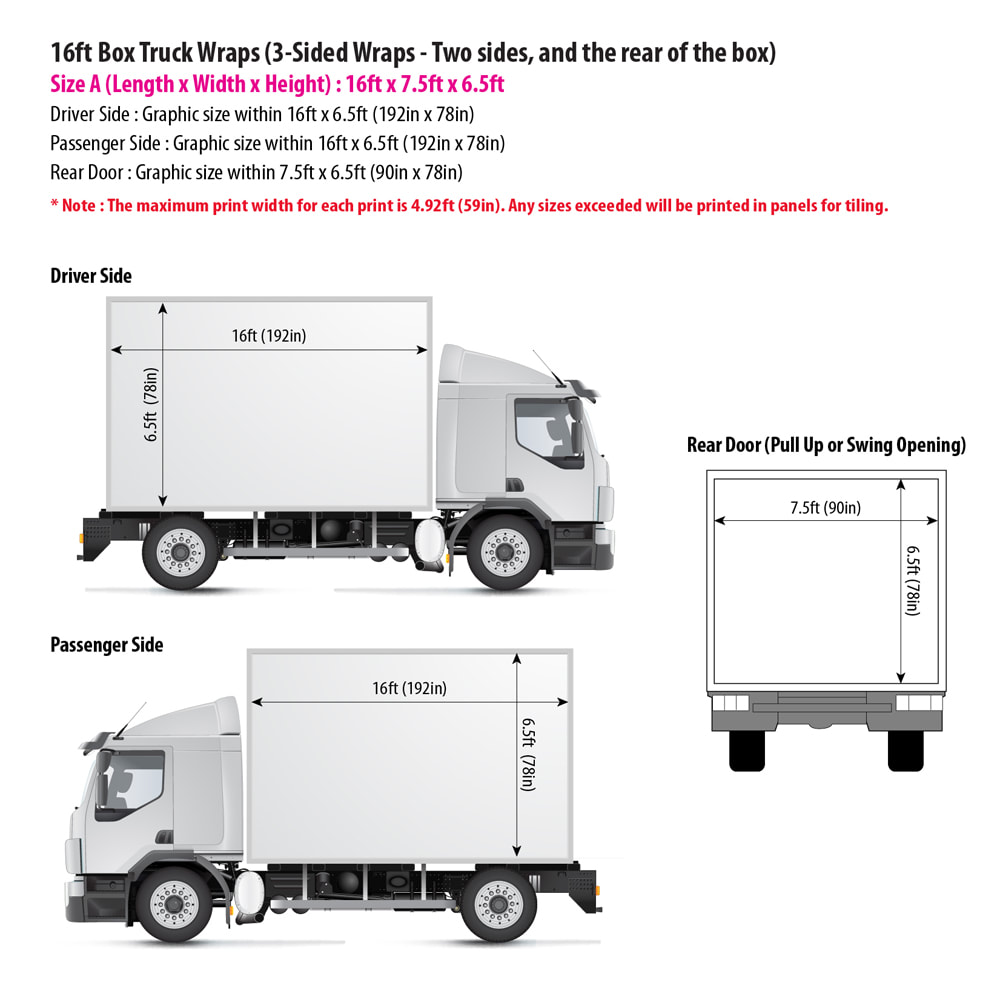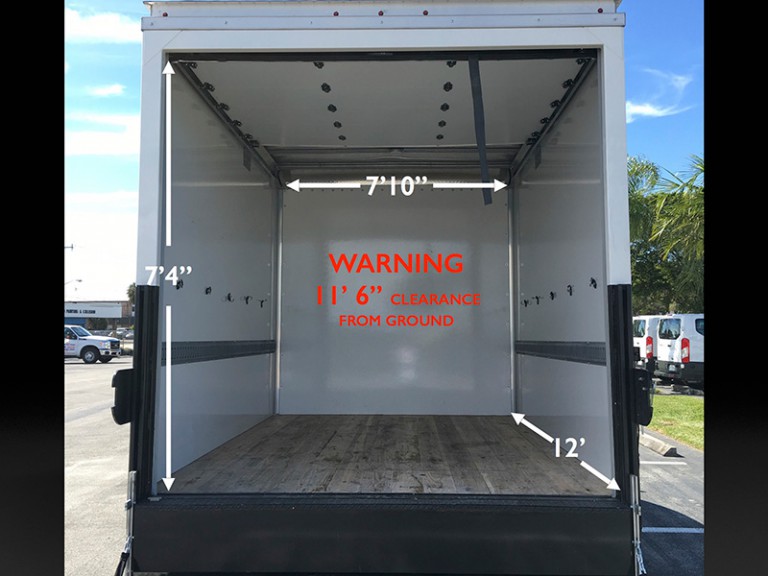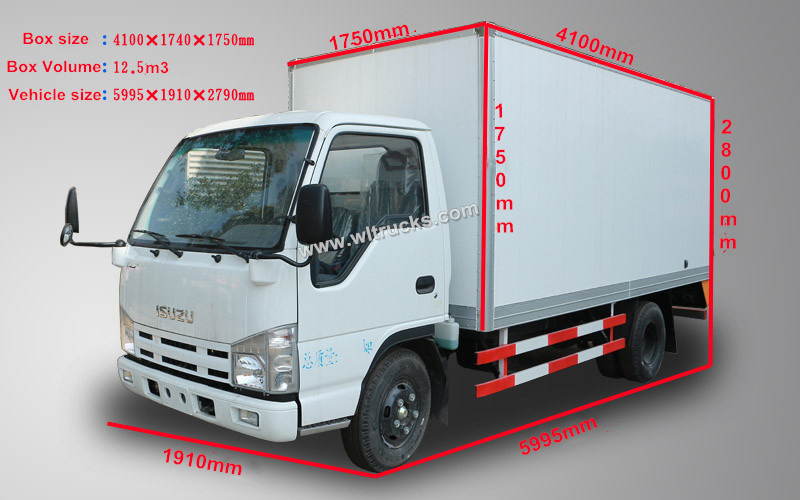Box Truck Dimensions: Your Ultimate Guide to Choosing the Right Size types.truckstrend.com
Introduction: The Criticality of Cubic Feet and Payload
In the world of logistics, moving, and commercial transport, the box truck stands as a versatile workhorse. From individuals relocating their homes to businesses distributing goods, these enclosed vehicles offer a secure and efficient way to move cargo. However, the seemingly straightforward task of selecting a box truck often overlooks a crucial element: its dimensions. Understanding "Box Truck Dimensions" isn’t merely about knowing its length; it’s about grasping the intricate interplay of interior space, exterior measurements, weight capacities, and how these factors dictate everything from operational efficiency and safety to legal compliance and overall cost.
Box Truck Dimensions: Your Ultimate Guide to Choosing the Right Size
Choosing the wrong size can lead to a multitude of problems: a truck too small means multiple trips, wasted time, and increased fuel costs; a truck too large means unnecessary expense, challenging maneuverability, and potentially exceeding legal limits. This comprehensive guide will delve deep into the various facets of box truck dimensions, providing you with the knowledge and practical advice needed to make informed decisions for your next move or logistical operation.
Understanding Box Truck Dimensions: The Core Elements
Before diving into specific sizes, it’s essential to define the key dimensional aspects that characterize any box truck. Each measurement plays a vital role in its utility and operational constraints.
- Interior Cargo Length: This is the most commonly cited dimension, referring to the usable length of the cargo area from the rear door to the front wall. It’s crucial for determining how many large items (e.g., sofas, refrigerators) can fit end-to-end.
- Interior Cargo Width: The width of the cargo bay, measured from wall to wall. This dictates how wide your largest items can be and how much side-by-side packing is possible. Note that wheel wells often protrude into this space, reducing usable floor width.
- Interior Cargo Height: The vertical clearance inside the cargo area. This is critical for standing taller items upright and for ensuring adequate headroom for loading and unloading.
- Exterior Length: The total length of the entire vehicle, from bumper to bumper. This is important for parking, navigating tight turns, and understanding the vehicle’s overall footprint.
- Exterior Width: The total width of the vehicle, including mirrors. Essential for navigating narrow streets, alleys, and checking clearances through gates or doorways.
- Exterior Height: The total height of the vehicle from the ground to the highest point (usually the top of the box). This is arguably the most critical exterior dimension, as it directly impacts clearance under bridges, tunnels, and low-hanging structures. Ignoring this can lead to catastrophic accidents.
- Gross Vehicle Weight Rating (GVWR): This is the maximum permissible total weight of the truck, including the vehicle itself, its fuel, passengers, and all cargo. It’s a critical safety and legal limit, often determining whether a Commercial Driver’s License (CDL) is required.
- Payload Capacity: The maximum weight of cargo that the truck can safely carry. This is calculated by subtracting the truck’s curb weight (empty weight) from its GVWR. It’s just as important as volume; a truck might have enough space but not enough weight capacity for dense items.
- Cubic Feet (Volume): This is the total interior volume of the cargo area, calculated by multiplying interior length x width x height. It provides the most accurate measure of how much "stuff" (not necessarily weight) a truck can hold.


Common Box Truck Sizes and Their Applications
Box trucks come in a variety of standard sizes, each suited for different types of jobs. Understanding these common categories will help you narrow down your options.
- 10-Foot Box Truck:

- Typical Interior: Approx. 9’10" L x 6’3" W x 6’2" H (300-400 cu. ft.)
- Payload: 2,800 – 3,500 lbs
- Use: Ideal for studio apartments, small dorm rooms, local deliveries, or transporting a few large pieces of furniture. Often easy to drive, similar to a large van.
- 12-Foot Box Truck:
- Typical Interior: Approx. 12′ L x 6’6" W x 6’6" H (400-500 cu. ft.)
- Payload: 3,000 – 3,800 lbs
- Use: Suitable for 1-bedroom apartments or small offices. Offers slightly more space than the 10-foot for slightly larger moves.
- 15-Foot Box Truck:
- Typical Interior: Approx. 14’6" L x 7’8" W x 7’2" H (700-800 cu. ft.)
- Payload: 4,000 – 6,000 lbs
- Use: A popular choice for 1-2 bedroom homes or medium-sized apartments. Can handle most standard household items, including appliances and larger furniture.
- 16-Foot Box Truck:
- Typical Interior: Approx. 16′ L x 7’8" W x 7’2" H (800-900 cu. ft.)
- Payload: 5,000 – 7,000 lbs
- Use: Similar to the 15-foot but offers a bit more length. Good for 2-3 bedroom homes or slightly larger commercial deliveries. Often the largest size that is relatively easy to maneuver for novice drivers.
- 20-Foot Box Truck:
- Typical Interior: Approx. 19’6" L x 7’8" W x 7’2" H (1,000-1,200 cu. ft.)
- Payload: 6,000 – 8,000 lbs
- Use: Designed for 2-4 bedroom homes or significant commercial cargo. Requires more caution in driving and parking due to its increased length.
- 24-Foot Box Truck:
- Typical Interior: Approx. 23’6" L x 8′ W x 8′ H (1,400-1,600 cu. ft.)
- Payload: 8,000 – 10,000 lbs
- Use: Ideal for large 4+ bedroom homes, significant commercial hauling, or long-distance moves. Often comes with a lift gate.
- 26-Foot Box Truck:
- Typical Interior: Approx. 26′ L x 8′ W x 8′ H (1,500-1,700 cu. ft.)
- Payload: 9,000 – 12,000 lbs
- Use: The largest common rental size, perfect for very large homes, full commercial loads, or heavy equipment transport. Almost always equipped with a lift gate and often requires more driving experience.
Key Considerations When Choosing Box Truck Dimensions
Selecting the right box truck goes beyond simply picking a size based on a rough estimate. Several critical factors must be thoroughly considered.
- Cargo Volume vs. Weight: Don’t fall into the trap of only considering cubic feet. If you’re moving heavy items like books, tools, or dense machinery, you could hit the payload capacity limit long before you fill the truck’s volume. Always estimate both.
- Route and Destination Constraints:
- Bridge Clearances: Crucial for taller trucks. Know your truck’s exterior height and plan your route to avoid low bridges or tunnels. GPS systems for trucks can help with this.
- Narrow Streets/Alleys: Larger trucks have a wider turning radius and are harder to maneuver in tight urban environments or residential cul-de-sacs.
- Loading Dock Accessibility: If you’re using a commercial loading dock, ensure the truck’s height and length are compatible.
- Parking: Finding parking for a 26-foot truck can be a significant challenge, especially in residential areas or city centers.
- Driver Experience: Driving a large box truck is significantly different from driving a car. Larger vehicles require more stopping distance, wider turns, and greater awareness of surroundings. If you’re an inexperienced driver, opt for a smaller truck if possible.
- Licensing Requirements: Most rental box trucks (up to 26 feet) for personal use fall under the non-CDL category (typically under 26,000 lbs GVWR). However, if you’re using a larger commercial truck or a truck with a high GVWR, a CDL might be required. Always verify the GVWR and your local licensing laws.
- Special Features:
- Lift Gates/Ramps: These are invaluable for heavy items but they take up space and add to the truck’s curb weight, reducing payload capacity.
- Tie-Downs: Essential for securing cargo. Ensure there are enough and they are in good condition.
- E-track Systems: Common in commercial trucks, these allow for flexible tie-down points and load bars, optimizing space and security.
Measuring Your Needs: A Practical Guide
To accurately determine the box truck dimensions you need, follow these steps:
- Inventory Your Items: Make a detailed list of everything you plan to move. For a home move, categorize by room. For commercial goods, categorize by type and quantity.
- Estimate Cubic Feet:
- For Home Moves: Use online cubic foot calculators for common household items (e.g., a refrigerator is ~25-30 cu. ft., a sofa ~50-80 cu. ft.). Alternatively, use a "room count" estimation (e.g., a 1-bedroom apartment needs a 10-12 ft truck, a 3-bedroom needs a 20-24 ft truck). Always round up if unsure.
- For Commercial Cargo: If you have dimensions for your boxes/pallets, multiply their L x W x H to get individual cubic feet, then sum them up.
- Estimate Weight: This is often overlooked. If you have very heavy items (e.g., a safe, machinery, large book collection), estimate their weight. Research average weights of common appliances and furniture. Add up the estimated weights of all items. Compare this total to the payload capacity of your chosen truck size.
- Consider Packing Efficiency: A well-packed truck utilizes space much better than a poorly packed one. Account for irregular shapes and void spaces.
- Plan Your Route: Before finalizing, use a mapping tool to check your route for potential low clearances (bridges, overpasses) and tight turns. Many commercial GPS systems have a "truck mode" where you can input your vehicle’s height.
Challenges and Solutions Related to Box Truck Dimensions
Even with careful planning, challenges can arise. Being prepared can save you time and stress.
- Challenge: Underestimating Space/Weight:
- Solution: Always err on the side of caution. If you’re on the fence between two sizes, choose the larger one. The small increase in rental cost is far less than the cost and hassle of a second trip or an overloaded vehicle. Use online moving calculators and detailed item lists.
- Challenge: Navigating Tight Spaces (e.g., Driveways, Alleys):
- Solution: Plan your approach. If possible, scout the location beforehand. Use a spotter (someone outside the truck) to guide you when backing up or maneuvering in confined areas. Take wide turns.
- Challenge: Bridge Height Restrictions:
- Solution: Before you even leave the rental lot, know your truck’s exact exterior height (it’s usually posted inside the cab or on a sticker). Use a truck-specific GPS app or cross-reference your route with state Department of Transportation (DOT) low clearance maps. Never guess.
- Challenge: Overloading:
- Solution: Distribute weight evenly across the truck’s floor. Place heavier items towards the front (closer to the cab) and low to the ground. Never exceed the GVWR or payload capacity. If you suspect you’re close, find a public weigh station (often at truck stops or landfills) to check.
Maximizing Efficiency and Safety
Once you have your box truck, proper loading and driving techniques are paramount for both efficiency and safety.
- Load Smart:
- Heavy First: Load heaviest items on the floor, towards the front of the truck. This helps with weight distribution and prevents instability.
- Distribute Weight Evenly: Avoid putting all the weight on one side.
- Stack Vertically: Utilize the height of the truck by stacking boxes and items.
- Fill Gaps: Use blankets, pillows, or smaller boxes to fill voids and prevent shifting.
- Secure Your Cargo: Use tie-downs, ropes, or E-track straps to secure all items. Shifting cargo can cause damage and make the truck unstable, especially during braking or turns.
- Pre-Trip Inspection: Before driving, check tires, lights, brakes, and mirrors. Adjust mirrors for maximum visibility, especially for blind spots.
- Drive Defensively: Allow for greater stopping distances. Take turns wider than you would in a car. Be mindful of wind, which can significantly affect a tall box truck.
Box Truck Dimensions & Illustrative Rental Prices
The table below provides a quick reference for common box truck dimensions, their typical payload capacities, and illustrative average daily rental prices. Please note that prices are highly variable based on location, provider, time of year, demand, and additional fees (mileage, insurance, fuel).
| Box Truck Size (Nominal Length) | Typical Interior Cargo Dimensions (L x W x H) | Approx. Payload Capacity (lbs) | Illustrative Average Daily Rental Price* | Ideal Use Case |
|---|---|---|---|---|
| 10 ft. | 9’10" x 6’3" x 6’2" | 2,800 – 3,500 | $19.95 – $39.95 | Studio/Small Apt., Local Deliveries |
| 12 ft. | 12′ x 6’6" x 6’6" | 3,000 – 3,800 | $29.95 – $49.95 | 1-Bedroom Apt., Furniture |
| 15 ft. | 14’6" x 7’8" x 7’2" | 4,000 – 6,000 | $39.95 – $69.95 | 1-2 Bedroom Home, Small Business |
| 16 ft. | 16′ x 7’8" x 7’2" | 5,000 – 7,000 | $49.95 – $79.95 | 2-3 Bedroom Home, Mid-size Commercial |
| 20 ft. | 19’6" x 7’8" x 7’2" | 6,000 – 8,000 | $59.95 – $89.95 | 2-4 Bedroom Home, Larger Commercial |
| 24 ft. | 23’6" x 8′ x 8′ | 8,000 – 10,000 | $79.95 – $119.95 | 4+ Bedroom Home, Large Commercial |
| 26 ft. | 26′ x 8′ x 8′ | 9,000 – 12,000 | $89.95 – $139.95 | Very Large Homes, Heavy Commercial Use |
Note: Prices are illustrative daily rental averages and do not include mileage, fuel, insurance, environmental fees, or other charges. Actual prices vary significantly by location, provider, demand, and rental duration.
Frequently Asked Questions (FAQ) About Box Truck Dimensions
Q1: What is GVWR and why is it important for box trucks?
A1: GVWR stands for Gross Vehicle Weight Rating. It’s the maximum operating weight of a vehicle as specified by the manufacturer, including the vehicle’s empty weight, fuel, passengers, and all cargo. It’s crucial because exceeding the GVWR is illegal, unsafe, and can void insurance or lead to fines. It also often determines whether a Commercial Driver’s License (CDL) is required.
Q2: Do I need a CDL to drive a box truck?
A2: For most common rental box trucks (up to 26 feet in length), a standard Class D (regular) driver’s license is sufficient, as their GVWR typically falls below the 26,001 lbs threshold that requires a CDL in the U.S. However, always verify the specific truck’s GVWR and your local state laws, especially if operating commercially or with heavier loads.
Q3: How do I measure a box truck’s height for bridge clearances?
A3: The exterior height of the box truck is usually posted on a sticker inside the cab or on the driver’s side door jamb. If not, measure from the ground to the highest point of the truck (usually the top of the box). Always use this exact measurement when checking bridge or tunnel clearances, and add a small buffer for safety.
Q4: Can I tow a car or trailer with a box truck?
A4: Many box trucks, especially those rented from major moving companies, come equipped with a tow hitch. However, not all do, and some sizes might not be suitable for towing. Always check with the rental company or the truck’s specifications for its towing capacity before attempting to tow.
Q5: What’s the difference between nominal length and usable interior length?
A5: "Nominal length" (e.g., "15-foot truck") is a general marketing term. The "usable interior length" is the actual, practical length of the cargo space available inside the box. The nominal length might include the cab or simply be a rounded figure. Always confirm the interior dimensions for precise planning.
Q6: How much space do I really need for a typical home move?
A6:
- Studio/Small 1-Bedroom: 10-12 ft truck (approx. 300-500 cu. ft.)
- 1-2 Bedroom Apartment/Small Home: 15-16 ft truck (approx. 700-900 cu. ft.)
- 2-3 Bedroom Home: 20 ft truck (approx. 1,000-1,200 cu. ft.)
- 3-4+ Bedroom Home: 24-26 ft truck (approx. 1,400-1,700 cu. ft.)
These are estimates; always consider the volume and weight of your specific belongings.
Conclusion: Making Informed Decisions
Understanding box truck dimensions is far more than a logistical detail; it’s a foundational aspect of successful and safe transport. From ensuring your precious belongings fit securely to navigating complex urban environments without incident, every dimension plays a crucial role. By carefully considering your cargo’s volume and weight, evaluating your route, understanding legal requirements, and leveraging the practical advice outlined in this guide, you empower yourself to choose the perfect box truck for your needs. The right dimensions mean efficiency, safety, and peace of mind, transforming what could be a stressful endeavor into a smooth, successful operation. Plan wisely, measure accurately, and drive confidently.
